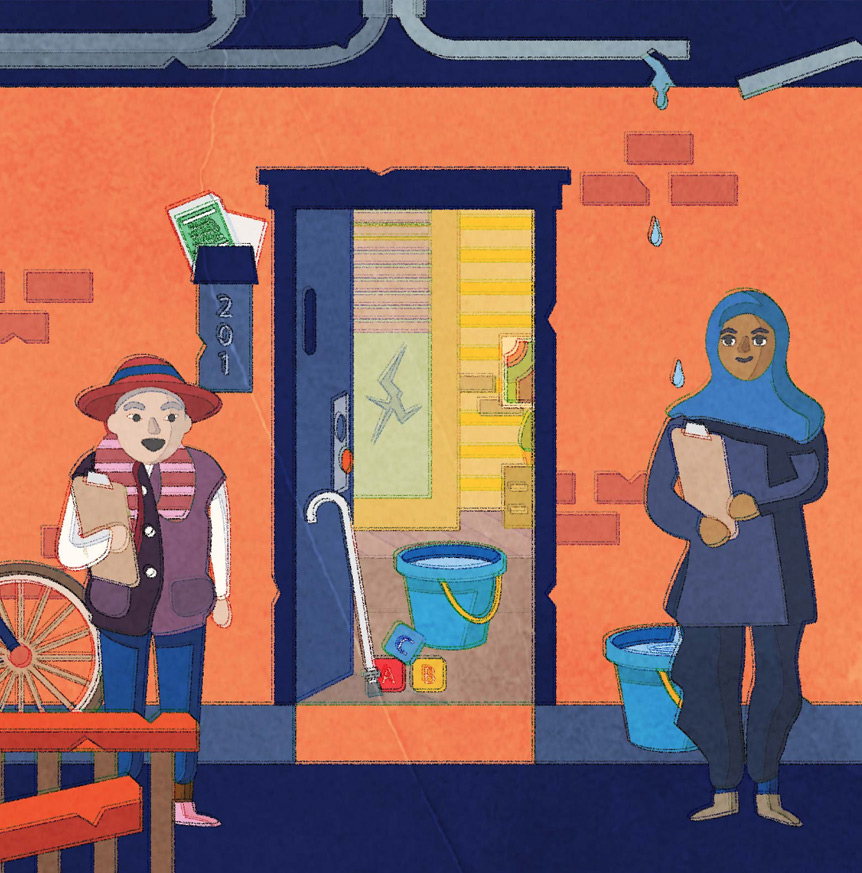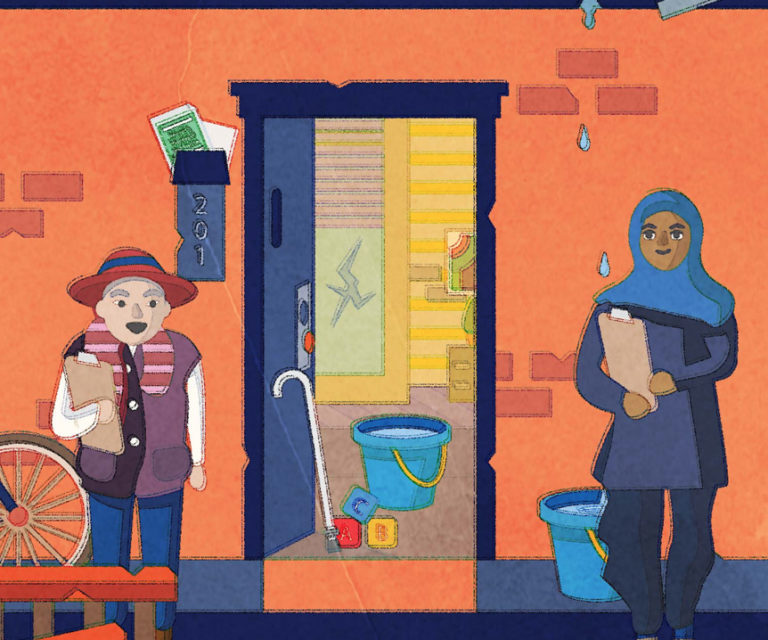 Lately, your neighborhood has started to change. New development is happening everywhere! Shops, luxury housing, restaurants, bars—and new people are moving into your neighborhood who can afford to pay more for housing than you can.
Lately, your neighborhood has started to change. New development is happening everywhere! Shops, luxury housing, restaurants, bars—and new people are moving into your neighborhood who can afford to pay more for housing than you can.
Now your landlord is putting pressure on you to move out of your apartment. The place is already in poor condition. They haven’t made repairs that they’re supposed to in several months. But even though the place isn’t that nice, you can’t afford to move out into one of the new, luxury developments in the neighborhood. And you really don’t want to leave the community you’ve called home for a long time. But what other choice do you have?
You can organize to stay in your home and neighborhood!
Imagine conditions in the building where you live are different. Instead of the landlord having power over you and the conditions you’re living in, they have to respond to your needs. You and your neighbors have all come together. Your landlord takes you seriously and because of that, you can stay in your apartment. Your building conditions are safe and clean. Repairs have been made in your apartment, and you know that if you have any problems, management will be responsive to your concerns. Plus, your tenant association has power in your community. Elected officials visit you regularly to campaign for your vote. When a new development happens in your community, your tenant association has power in determining what happens in your neighborhood. When we come together as tenants and neighbors, we have the power to determine what happens in our community!
So you’re ready to organize, but don’t know where to start? If you’re at risk of eviction, are facing an unfair rent increase, or have poor conditions in your housing, you can start by organizing a tenant association in the building where you live. Or, if you’re more interested in organizing for change in your neighborhood (not just your building), you can read Building Neighborhood Power.
What is a tenant association?
A tenant association is a group of neighbors who come together around a shared set of interests in their building. Tenant associations fight for repairs. They organize against landlord harassment, illegal rent increases, and advocate for improved conditions for residents in a building. When residents in a building come together around a shared set of concerns, their voices are amplified, and they have more power to get their needs met.
How do I start a tenant association?
The first step in forming a tenant association is talking to other people who live in your building to see if you have shared experiences. When we have problems with our housing, we think we’re alone. We feel like we’re the only ones in our building with leaks in our ceilings, have gotten our heat cut off in the winter, or taken to court for no reason. When you start talking with other people in your building, you’ll begin to see that other people are having the same issues as you. Once you’ve gotten to know the other people in your building, you’re ready to host your first tenant association meeting.
 The best way to meet other people in your building is to knock on their door and introduce yourself. If you’re nervous when you start out, here’s a sample doorknocking script that you can use to guide your opening conversation.
The best way to meet other people in your building is to knock on their door and introduce yourself. If you’re nervous when you start out, here’s a sample doorknocking script that you can use to guide your opening conversation.

The first tenant association meeting is a place where you can connect with other people in your building and start to build a relationship with each other and discuss the changes you would like to see in your building. You can also invite a lawyer or tenant advocacy group to help you get to know your tenant rights-- especially if you’re experiencing harassment from your landlord. Tenant associations don’t just have to be spaces where you meet when there are problems. You can also have meetings to socialize and get to know your neighbors! Here’s a sample agenda you can use to guide your first meeting.

Tenant associations usually have a leadership team that sets the agenda for their meetings, reaches out to others living in the building, and liaises with a lawyer and community organizations. Some tenant associations have a lot of structure with officer positions and formal procedures. Other tenant associations have steering committees, or a model of shared leadership that is non hierarchical. Whatever the leadership structure is, the leadership should engage more people in your meetings—the more people feel like they have a stake in what’s happening in the organization, the more likely they are to participate! See here for an additional list of recommended roles.
Once you’ve started to organize your tenant association, and have gotten a sense of the problems in your building, it’s time to start your campaign.
What is a campaign?
A campaign is your plan to win lasting change on an issue that you care about. In a tenant association, campaigns can be to improve conditions, stop an unjust rent increase, or stop evictions in your building.
A strategy is a thought out action plan that will help you reach victory. No matter the issue, every campaign has a strategy.
The first step in your organizing campaign strategy is to do more research about the building where you live and its owner.
Here is some research you can do to be more prepared before you start your campaign:
1. Identify who owns your building
Your landlord may be an individual that you’re well acquainted with, or it could be a larger developer. Sometimes you will have to do additional research to find out who really owns your building. For help with this, you can reach out to a community organization to assist you.
2. Find out what other buildings they own
Does your landlord own buildings anywhere else in your city or state? Or even the country? When you are connected with other buildings they own, you have more power to challenge your landlord.
3. Search the city records for “code violations”
In a lot of cities, it’s possible to file “code violations” or complaints about conditions to the city or state Department of Housing. Check to see if any of the people in your building have already registered complaints, or if the landlord’s other buildings also have similar conditions. Seeing the building violations in your building can also be a good way to find other tenants to join your tenant association, because these will be people who’ve already engaged in taking some action about their living situation.
4. See if your landlord is mentioned in the media
Have there been any other stories about the landlord’s buildings and the living conditions in the media? Have other tenants organized before you? It’s also possible that there are records of recent purchases they’ve made. For example, have they bought up a whole block in your neighborhood and not just your building? Some landlords are on city wide “watch lists” which include the worst landlords in the city. Knowledge is power - find out as much as you can!
5. Find out as much as you can about your landlord
Do they participate in local organizations? Do they attend a local place of worship? Do they donate to any charities? If you have a good sense of who your landlord is as a person, you can identify ways to persuade them to meet your demands. The more you know about them the better your chance of being able to influence them.

Once you have a solid leadership team within your tenant association, you’re ready to hold a meeting with the landlord.
Make sure your group is prepared:
Draft your list of demands
Make sure you have a list of demands ready before the meeting so that you can present it to the landlord. You can email it to them before the meeting or bring a handwritten copy. You could even organize a press conference or demonstration to deliver the demands to the landlord. The option you use depends on your existing relationship with the landlord and how much pressure you think they’ll need to meet with you or be responsive to your needs.
Finalize speaking roles
It’s good to have two to three representatives at most prepared to speak about the conditions you’re dealing with in the building and what your demands are as a group. Each speaker should have talking points and consider having a practice meeting, so you know what each of you will say.
Know your rights
The landlord may try to intimidate you or other tenants at the meeting by telling you that you don’t have the right to organize, yelling at you, singling out individual tenants, or even threatening to call the police or ICE. It may be helpful to have an attorney with you to help you feel safe.
 What if my landlord doesn’t come to the meeting?
What if my landlord doesn’t come to the meeting?
Sometimes landlords won’t come to a tenant association meeting. If that happens, you can take more visible public action, like a press conference or demonstration to get their attention. Alternately, you could file housing code violations with the city, or a lawsuit in court. You have a range of tactics which could get the landlord’s attention.
What if my landlord agrees to our demands?
Sometimes the landlord will agree to meet your demands. Be wary of this. It’s possible that they will make only a few minor changes, and that the problems will continue if they haven’t dealt with all of the building-wide issues. Always have a backup plan for how you want to take action if they don’t meet all of your demands. It’s also important to keep meeting regularly as a tenant association, as landlords will be more responsive to your requests if they see that you are organized.
What if my landlord says I’m not allowed to meet in the building?
Landlord- tenant laws are different in each state or city. Some laws protect the right to organizing, including the right to meet in your building. Others don’t. It’s important to understand what your tenant rights are, including what the law says about tenant organizing in your city. You can contact a local tenant rights organization or your city or state housing department to find more resources.


